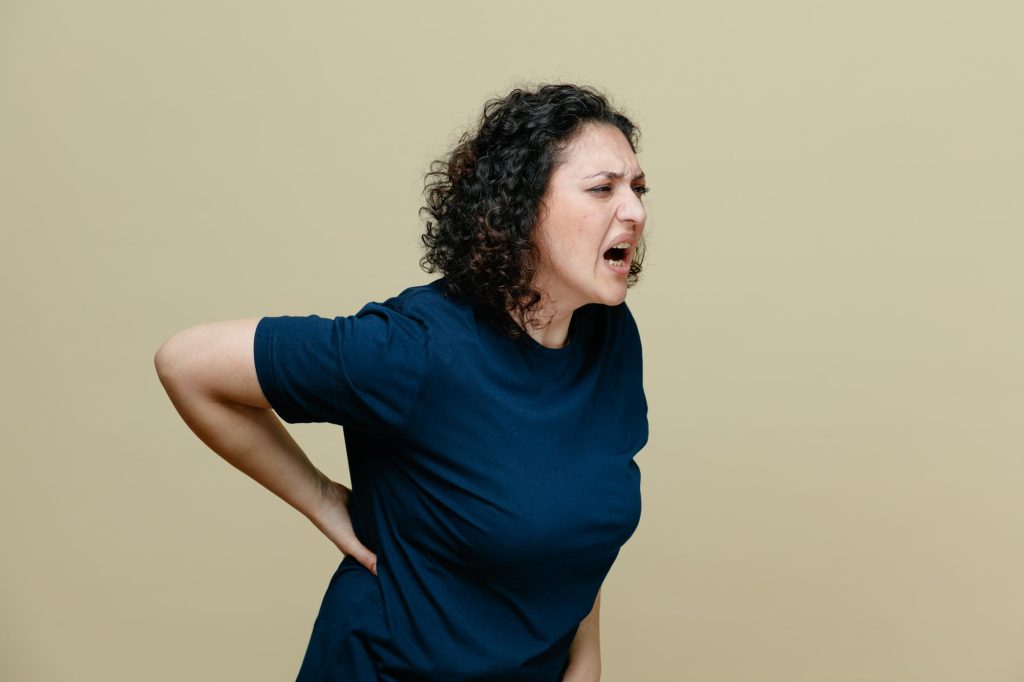Discover the potential causes and underlying conditions of persistent postpartum back pain.
Is Persistent Postpartum Back Pain a Sign of a More Serious Underlying Condition?
Many new mothers experience postpartum back pain, but is persistent pain a sign of a more serious problem? Let’s dive in and explore this topic together.

Understanding Postpartum Back Pain
After giving birth, your body goes through many changes. One common side effect is back pain. Understanding the anatomy of postpartum back pain can help you better manage it.
During pregnancy, the body undergoes significant changes to accommodate the growing baby. As the uterus expands, the center of gravity shifts forward, causing the spine to curve more than usual. This increased curvature can put strain on the muscles and ligaments in the back, leading to discomfort and pain.
In addition to the physical changes, hormonal shifts also play a role in postpartum back pain. The hormone relaxin, which is released during pregnancy to loosen the ligaments in the pelvis, can affect other joints in the body as well. This can result in increased flexibility and instability in the spine, making it more susceptible to injury and pain.
The Anatomy of Postpartum Back Pain
Postpartum back pain can involve muscles, ligaments, and even the spine itself. The physiological changes that occur during pregnancy, such as weight gain and hormonal shifts, can contribute to this discomfort.
When it comes to muscles, the abdominal muscles play a crucial role in supporting the spine. However, during pregnancy, these muscles stretch and weaken to accommodate the growing baby. This can lead to imbalances in muscle strength and stability, putting additional strain on the back muscles.
Ligaments, which are connective tissues that hold bones together, also undergo changes during pregnancy. The hormone relaxin, mentioned earlier, causes the ligaments to become more lax and flexible. While this is necessary for childbirth, it can also lead to instability in the spine and increase the risk of back pain.
Furthermore, the spine itself can be affected by postpartum back pain. The increased curvature of the spine during pregnancy can put pressure on the intervertebral discs, which act as shock absorbers between the vertebrae. This pressure can cause the discs to bulge or herniate, leading to nerve compression and radiating pain.
Common Causes of Postpartum Back Pain
Several factors can contribute to postpartum back pain. These may include strained muscles from the physical demands of childbirth, the hormone relaxin loosening ligaments, or changes in posture due to breastfeeding or carrying your baby.
Childbirth itself can put a significant strain on the muscles in the back. The process of pushing during labor requires the use of various muscles, including those in the back, abdomen, and pelvis. This exertion can lead to muscle soreness and fatigue, resulting in postpartum back pain.
In addition, the hormone relaxin, which is essential for childbirth, can continue to affect the ligaments even after giving birth. This can lead to ongoing instability in the spine and contribute to persistent back pain.
Changes in posture can also play a role in postpartum back pain. Breastfeeding, for example, often requires sitting or hunching forward for extended periods. This can strain the muscles in the back and contribute to discomfort. Similarly, carrying your baby can cause you to adopt different postures, such as leaning to one side or hunching over, which can put additional stress on the back.
It is important to note that postpartum back pain is a common occurrence and usually resolves on its own with time. However, if the pain persists or becomes severe, it is advisable to consult with a healthcare professional for further evaluation and guidance.
Distinguishing Normal from Persistent Postpartum Back Pain
It’s essential to differentiate between normal postpartum back pain and persistent pain that may indicate an underlying issue. Let’s explore the duration, intensity, and other factors that can help you identify persistent pain.
After giving birth, many women experience back pain as a result of the changes their bodies undergo during pregnancy. This pain is considered normal and is often attributed to the strain put on the back muscles and ligaments during pregnancy and childbirth. However, it’s important to note that not all postpartum back pain is the same.
Duration and Intensity of Normal Postpartum Back Pain
Normal postpartum back pain typically diminishes within a few weeks to a few months after giving birth. During this time, the body gradually heals and adjusts to its pre-pregnancy state. The pain experienced is usually mild to moderate and can be managed with simple remedies such as rest, gentle exercises, and over-the-counter pain relievers.
It’s important to remember that every woman’s experience with postpartum back pain is unique. While some may find relief within a few weeks, others may take a bit longer to recover. The key is to monitor the pain and ensure that it is gradually improving over time.
Identifying Persistent Postpartum Back Pain
If your back pain persists beyond the expected timeframe, increases in intensity, or interferes with mobility, it’s important to consult with your healthcare provider. While most postpartum back pain resolves on its own, persistent pain may be a sign of an underlying condition that requires medical attention.
There are several potential causes of persistent postpartum back pain. One common culprit is a herniated disc, which occurs when the soft cushioning between the vertebrae in the spine becomes damaged or displaced. This can cause sharp or shooting pain that radiates down the legs, making it difficult to perform daily activities.
Another possible cause of persistent postpartum back pain is sacroiliac joint dysfunction. This occurs when the joints that connect the sacrum (the triangular bone at the base of the spine) to the pelvis become inflamed or misaligned. The pain is typically felt in the lower back and buttocks and may worsen with certain movements or positions.
Other factors that may contribute to persistent postpartum back pain include muscle imbalances, poor posture, and weakened abdominal muscles. These issues can put additional strain on the back and lead to ongoing discomfort.
When consulting with your healthcare provider about persistent postpartum back pain, they will likely perform a thorough physical examination and may order diagnostic tests such as X-rays or MRI scans to identify the underlying cause. Treatment options may include physical therapy, pain medication, or, in severe cases, surgery.
It’s important to prioritize your well-being and seek medical attention if you are experiencing persistent postpartum back pain. By addressing the underlying cause, you can find relief and regain your quality of life as a new mother.
Potential Serious Underlying Conditions
While most postpartum back pain resolves on its own, there are cases where it may be linked to a more serious underlying condition. Let’s take a closer look at some of these conditions.
Postpartum back pain is a common complaint among new mothers, often attributed to the physical strain of pregnancy and childbirth. However, in rare cases, this pain may be caused by spinal conditions such as a herniated disc or spinal stenosis. These conditions occur when the discs between the vertebrae in the spine become damaged or the spinal canal narrows, putting pressure on the nerves. This can lead to intense and persistent back pain that requires medical attention.
When it comes to spinal conditions causing postpartum back pain, a herniated disc occurs when the soft inner core of a spinal disc protrudes through the tough outer layer, irritating nearby nerves. This can result in shooting pain, numbness, and tingling sensations in the back, buttocks, and legs. On the other hand, spinal stenosis is a condition where the spinal canal narrows, compressing the spinal cord and nerves. This can cause pain, weakness, and difficulty with mobility.
It’s important to note that these spinal conditions may require different treatment approaches compared to general postpartum back pain. While rest, gentle exercises, and pain medication may alleviate mild cases of postpartum back pain, more severe cases caused by spinal conditions may require physical therapy, spinal injections, or even surgery to relieve the pressure on the affected nerves.
In addition to spinal conditions, there are non-spinal conditions that can cause persistent postpartum back pain. These conditions should also be considered when evaluating the underlying causes of the pain. One such condition is pelvic floor dysfunction, which occurs when the muscles and connective tissues in the pelvic area become weakened or damaged. This can lead to pain in the lower back, pelvis, and hips, as well as urinary and bowel problems.
Another non-spinal condition that may cause postpartum back pain is abdominal muscle separation, also known as diastasis recti. This occurs when the abdominal muscles separate during pregnancy and fail to fully come back together after childbirth. The weakened abdominal muscles can put strain on the back, leading to pain and discomfort.
Endometriosis, a condition where the tissue lining the uterus grows outside of it, can also contribute to persistent postpartum back pain. The abnormal growth of endometrial tissue can cause inflammation and pain in the lower back, as well as other symptoms such as pelvic pain, painful periods, and fertility issues.
If you are experiencing postpartum back pain that persists or worsens over time, it is important to consult with a healthcare professional. They can help identify the underlying cause of the pain and recommend appropriate treatment options. Remember, understanding the potential serious underlying conditions associated with postpartum back pain can help ensure timely and effective management of the condition.
Diagnostic Procedures for Persistent Postpartum Back Pain
When persistent back pain is present, diagnostic procedures can help identify the underlying cause. Let’s explore some common methods used by healthcare providers.

Medical History and Physical Examination
Your healthcare provider will discuss your medical history and perform a physical examination to assess your condition. This helps them gather essential information to guide further diagnostic tests if needed.
Imaging Tests and Their Role
In some cases, imaging tests such as X-rays, MRIs, or CT scans may be necessary to visualize the spine and surrounding structures. These tests can provide valuable insights into potential underlying conditions and guide appropriate treatment strategies.
Treatment Options for Persistent Postpartum Back Pain
Thankfully, many treatment options are available for persistent postpartum back pain. Let’s explore some non-surgical treatments and therapies that can help alleviate discomfort.
Non-Surgical Treatments and Therapies
Non-surgical approaches may include physical therapy, chiropractic care, acupuncture, or massage therapy. These therapies can help strengthen muscles, improve posture, and reduce pain.
When Surgery Might Be Necessary
In some instances, surgery may be considered for persistent postpartum back pain caused by conditions such as a herniated disc. However, surgical intervention is typically reserved for cases where conservative treatments have not provided adequate relief.
In conclusion, while most postpartum back pain is transient and normal, persistent pain may be a sign of an underlying condition. It is crucial to pay attention to the duration, intensity, and other associated symptoms. Consulting with a healthcare provider will help determine the best course of action to alleviate discomfort and promote your well-being as a new mother.



